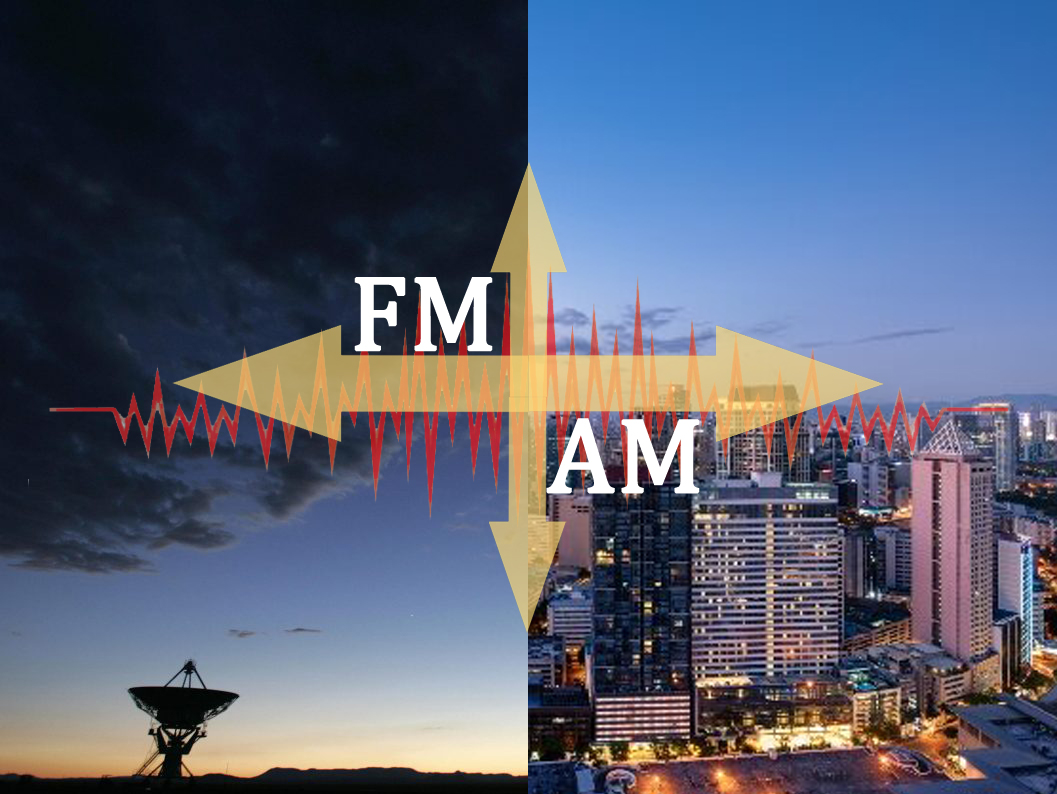Products Category
- FM Transmitter
- 0-50w 50w-1000w 2kw-10kw 10kw+
- TV Transmitter
- 0-50w 50-1kw 2kw-10kw
- FM Antenna
- TV Antenna
- Antenna Accessory
- Cable Connector Power Splitter Dummy Load
- RF Transistor
- Power Supply
- Audio Equipments
- DTV Front End Equipment
- Link System
- STL system Microwave Link system
- FM Radio
- Power Meter
- Other Products
- Special for Coronavirus
Products Tags
Fmuser Sites
- es.fmuser.net
- it.fmuser.net
- fr.fmuser.net
- de.fmuser.net
- af.fmuser.net ->Afrikaans
- sq.fmuser.net ->Albanian
- ar.fmuser.net ->Arabic
- hy.fmuser.net ->Armenian
- az.fmuser.net ->Azerbaijani
- eu.fmuser.net ->Basque
- be.fmuser.net ->Belarusian
- bg.fmuser.net ->Bulgarian
- ca.fmuser.net ->Catalan
- zh-CN.fmuser.net ->Chinese (Simplified)
- zh-TW.fmuser.net ->Chinese (Traditional)
- hr.fmuser.net ->Croatian
- cs.fmuser.net ->Czech
- da.fmuser.net ->Danish
- nl.fmuser.net ->Dutch
- et.fmuser.net ->Estonian
- tl.fmuser.net ->Filipino
- fi.fmuser.net ->Finnish
- fr.fmuser.net ->French
- gl.fmuser.net ->Galician
- ka.fmuser.net ->Georgian
- de.fmuser.net ->German
- el.fmuser.net ->Greek
- ht.fmuser.net ->Haitian Creole
- iw.fmuser.net ->Hebrew
- hi.fmuser.net ->Hindi
- hu.fmuser.net ->Hungarian
- is.fmuser.net ->Icelandic
- id.fmuser.net ->Indonesian
- ga.fmuser.net ->Irish
- it.fmuser.net ->Italian
- ja.fmuser.net ->Japanese
- ko.fmuser.net ->Korean
- lv.fmuser.net ->Latvian
- lt.fmuser.net ->Lithuanian
- mk.fmuser.net ->Macedonian
- ms.fmuser.net ->Malay
- mt.fmuser.net ->Maltese
- no.fmuser.net ->Norwegian
- fa.fmuser.net ->Persian
- pl.fmuser.net ->Polish
- pt.fmuser.net ->Portuguese
- ro.fmuser.net ->Romanian
- ru.fmuser.net ->Russian
- sr.fmuser.net ->Serbian
- sk.fmuser.net ->Slovak
- sl.fmuser.net ->Slovenian
- es.fmuser.net ->Spanish
- sw.fmuser.net ->Swahili
- sv.fmuser.net ->Swedish
- th.fmuser.net ->Thai
- tr.fmuser.net ->Turkish
- uk.fmuser.net ->Ukrainian
- ur.fmuser.net ->Urdu
- vi.fmuser.net ->Vietnamese
- cy.fmuser.net ->Welsh
- yi.fmuser.net ->Yiddish
What is the Difference between AM and FM?
"What are FM and AM and what are the differences between them? What are the advantages and disadvantages? The following article will clearly explain in detail the similarities and differences between AM and FM from the meaning and application of AM and FM ------ FMUSER."
4) Difference between AM receiver and FM receiver
6) What are the Differences Between AM and FM Radio Signals
7) Advantages and Disadvantages of AM and FM | AM,FM
8) Conclusion
FM-Frequency Modulation techonology is widely used in: FM radio, telemetry, radar and seismic prospecting, EEG monitoring music synthesis, magnetic tape-recording systems, Doppler effect, sound and radio, FM transmitter, etc.
AM-Amplitude Modulation techonology is used in:Broadcast transmissions: Air band radio Single sideband Quadrature amplitude modulation frequency division multiplexing Hapburg carrier AM transmitter
People asks questions about like:
● What is the meaning of AM and FM?
● Which is better AM or FM?
● Why is AM radio still used?
● Where do we use AM and FM?
● What are the advantages of FM over AM?
● What are the applications of FM?
● Why is FM radio better than AM?
etc...
You may find all the ansewers in the passage, let's see about it!
● Amplitude Modulation (AM) :
AM transmits sound by changing the signal strength.
In AM, the voltage or power level of the information signal changes the amplitude of the carrier in proportion. With no modulation, the AM carrier is transmitted by itself (see Fig.1). When the modulating information signal (a sine wave) is applied, the carrier amplitude rises and falls in accordance. The carrier frequency remains constant during AM.

Fig.1: The Transmission of AM Signals
See Also: >>Amplitude Modulation in RF: Theory, Time Domain, Frequency Domain
● Frequency Modulation (FM) :
FM transmits sound by changing the frequency of the signal.
In the late nineteenth century, humans discovered that sound could be transmitted over airwaves, thus began the age of radio. Radio became the most popular form of transmission during the first eighty years of the twentieth century. There are two main different ways of transmitting radio signals, AM (Amplitude Modulation) and FM (Frequency Modulation).
See Also: >>What Is the Difference Between AM and FM Radio?
AM uses amplitude modulation to transmit sound. This method changes the strength of the signal, its amplitude in order to transmit.
An AM receiver then detects the amplitude variations in the radio waves at a particular frequency, and amplifies the changes in the signal voltage to drive a loudspeaker or earphones. The person then hears the original transmitted message. However, if the signal is not strong enough when it reaches the receiver, one hears only static.

Fig.2: Radio Broadcasting
AM usually broadcasts in mono which makes it sufficient for talk radio, whereas, FM can transmit in stereo which makes it ideal for music.
FMUSER
FMUSER
FM TV Transmitter Series
FMUSER
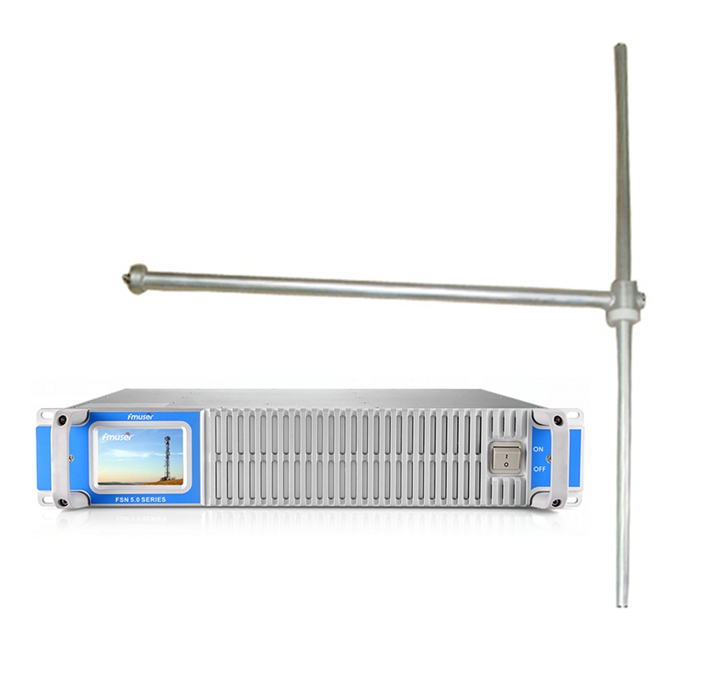
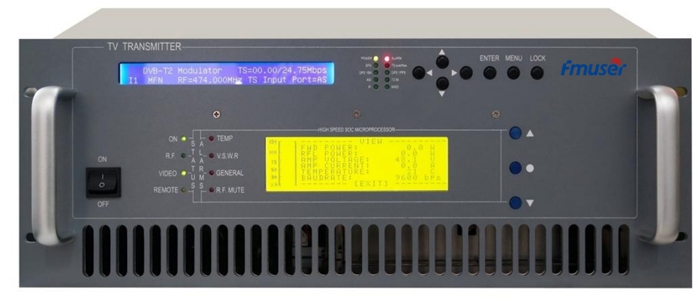

See Also: >>FMUSER FM Broadcast Transmitter for Sale
FM usually has a better signal quality than AM, but a far reduced range. AM has a much higher range than FM, which usually drops out 50KM from the radio station. Hence, FM has to use multiple transmitters to cover the same area as one AM transmitter. However, as AM travels by sound waves close to the Earth during the day and higher in the sky in the evening, it has a much smaller range in the day than in the night.

Fig.3: Signal Waves of AM&FM
See Also: >>How to Eliminate Noise on AM and FM Receiver
3) Radio Transmission
In radio communication systems, information is carried across space using radio waves. At the sending end, the information to be sent is converted by some type of transducer to a time-varying electrical signal called the modulation signal. The modulation signal may be an audio signal representing sound from a microphone, a video signal representing moving images from a video camera, or a digital signal consisting of a sequence of bits representing binary data from a computer.
The modulation signal is applied to a radio transmitter. In the transmitter, an electronic oscillator generates an alternating current oscillating at a radio frequency, called the carrier wave (see Fig.3) because it serves to "carry" the information through the air. The information signal is used to modulate the carrier, varying some aspect of the carrier wave, impressing the information on the carrier. Mostly used radio systems modulation methods:
● AM (amplitude modulation) – in an AM transmitter, the amplitude (strength) of the radio carrier wave is varied by the modulation signal.
● FM (frequency modulation) – in an FM transmitter, the frequency of the radio carrier wave is varied by the modulation signal.
##Below is an old training video from the U.S. Army that talks about the technical workings of AM and FM radio.##
4) AM receiver vs FM receiver | Difference between AM receiver and FM receiver
As we know the major blocks in any wireless communication system are modulator and demodulator. The modulator modulates the baseband information and demodulator demodulates the modulated signal to get back baseband. The modulator employs different modulation schemes to function. They are divided into linear modulation and angle modulation. The linear modulation types include DSB, AM, SSB and VSB. Angle modulation types include FM and PM. AM, FM and PM is the short form of Amplitude Modulation, Frequency Modulation and Phase Modulation respectively.
1. There are two main principles behind AM/FM radio system:
● To share the frequency spectrum i.e. many transmitters will use the same one medium.
● Demodulates desired signal and rejects all other signals transmitted simultaneously.
As we know source signal in AM/FM radio system is audio information. Different sources of voice information such as speech, music, hybrid signal(i.e. singing) will have different spectrum. Hence they will occupy different bandwidth. Speech occupies 4KHz, high-quality music specifies 15KHz, AM radio limits baseband bandwidth to about 5KHz and FM radio limits baseband bandwidth to 15KHz.
● Radio Station Transmitter
● Radio Receiver
Radio system i.e. radio receiver should be able to receive any type of audio source simultaneously. Different radio stations will share the frequency spectrum using AM and FM modulation types. Each radio station within a certain geographical area is assigned a carrier frequency around which it need to transmit. Sharing of AM/FM radio spectrum is achieved using FDM i.e. Frequency Division Multiplexing. Refer FDM vs TDM for more information.
3. Following are the requirements of a radio receiver.
● It should be cost effective, so a common man can afford.• It should work with both AM and FM signals
● It should tune to and amplify the desired radio station
● It should filter out all other stations
● Demodulator part has to work with all radio stations regardless of the carrier frequency
Figure depicts the combined block schematic of AM/FM receiver. Let us understand working of AM/FM radio receiver.

For the demodulator to work with any radio signal, we convert carrier frequency of any radio signal to IF (Intermediate frequency). Radio receiver is optimized to work with these IF frequencies. To achieve this, suitable IF filters and demodulators at those IF frequencies for AM and FM is designed.
See Also: >>What is the Difference between AM and FM?
|
Specifications |
AM |
FM |
|
Frequency Range |
540 to 1600 KHz |
88 to 108 MHz |
|
IF Frequency |
455 KHz |
10.7 MHz |
As mentioned in figure-1 a radio receiver consists of following modules:
● RF Section:
Tunes to desired RF frequency Fc. Includes RF BPF centered around Fc with desired baseband bandwidth. It passes desired radio station as well as nearby stations.
● RF to IF converter:
It converts carrier frequency to IF frequency. A local oscillator with variable frequency which varies with RF carrier frequency is used. This helps in tuning all the carrier frequencies to the same IF frequency. Here while tuning to the desired channel, we are tuning LO and RF filter simultaneously. In the mixing process, two frequencies are generated. The higher component is eliminated using filtering and we are left with IF filtering. The problem with this receiver is generation of image frequency at (Fc+2*FIF). This image frequency is also present at the output of RF-to-IF converter along with desired signal. This image frequency is eliminated using rf filtering. RF to IF is done in two stages in the radio receiver, it is known as super heterodyne receiver.
See Also: >>RF Filter Basics Tutorial
● IF filter:
Depending upon the type of received signal whether AM or FM appropriate IF filter is selected.
● Demodulator:
Output of IF filter is demodulated either using AM or FM demodulators. For AM,
● Audio Amplifier:
This module amplifies the demodulated baseband information.
6) What are the Differences Between AM and FM Radio Signals
FM stands for “Frequency Modulation,” and, unlike AM radio, sound is transmitted through changes in frequency. While both FM and AM radio signals experience frequent changes in amplitude, they are far less noticeable on FM.
AM stands for “Amplitude Modulation”, as AM radio signals vary their amplitude to adapt to the sound information that is being broadcasted through the wavelengths. While changes in amplitude occur on FM radio as well, they are more noticeable in AM radio because they result in audible static.
The following has explained the differences between AM and FM radio signals, let's see about it!
FM Signal
● The baseband signal determines the change in frequency of the carrier. Notice
that the spike doesn't change the frequency, so it won't be audible after demodulation
● FM has constant amplitude, and the demodulator won't be fooled by spikes in amplitude since it will detect variations in frequency.
● The contours are the baseband signal which we recover by demodulation.
● The demodulator doesn't "know" that the spike isn't actual part of the signal, so it can't remove it.
● The listener will hear a tick in the symphony she's listening to.
Modulated Types
Example
Notice
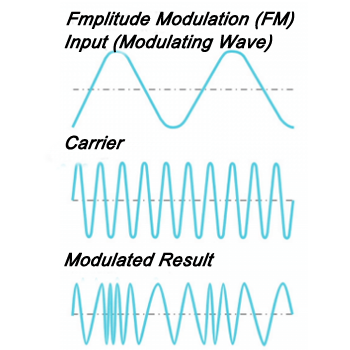
AM Signal
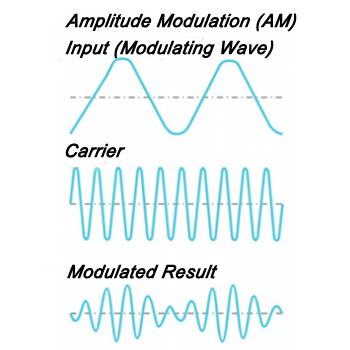
Demodulated Signal
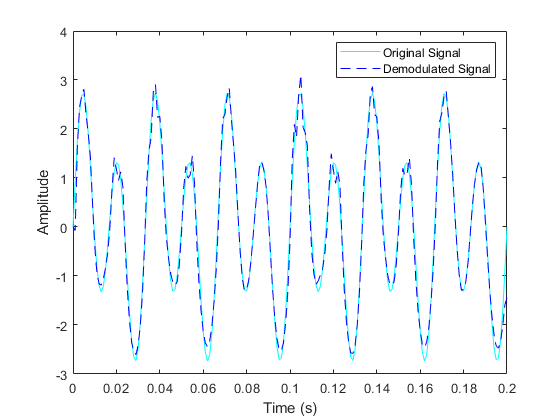
Note: There is a need for modulation and demodulation so that the information can be transmitted from one place to another. Modulation is used for sending the information over long distances as low-frequency signals cannot be used in covering large areas. Demodulation helps in receiving the information sent through modulation. Demodulation takes place at the receiving end.
7) Advantages and Disadvantages of AM and FM | AM,FM
The advantages of AM radio are that:
● It is relatively easy to detect with simple equipment, even if the signal is not very strong.
● It has a narrower bandwidth than FM, and wider coverage compared with FM radio.
The major disadvantage of AM is that:
● The signal is affected by electrical storms and other radio frequency interference.
● Although the radio transmitters can transmit sound waves of frequency up to 15 kHz, most receivers are able to reproduce frequencies only up to 5kHz or less. Wideband FM was invented to specifically overcome the interference disadvantage of AM radio.
Note: The basic nature of AM technology meant that the first radios could easily be mass produced. AM waves are easily affected by weather and large objects between the radio receiver and the transmitter. This means listeners experience different levels of quality on a daily basis while situated in the same place. AM's main advantage is its ability to follow the curve of the Earth and be received over long distances.
A distinct advantage that FM has over AM is that:
● FM radio has better sound quality than AM radio.
The disadvantage of FM signal is that:
● It is more local and cannot be transmitted over long distance. Thus, it may take more FM radio stations to cover a large area.
● Moreover, the presence of tall buildings or land masses may limit the coverage and quality of FM.
● Thirdly, FM requires a fairly more complicated receiver and transmitter than an AM signal does.
While both FM and AM radio signals experience frequent changes in amplitude, they are far less noticeable on FM. During an FM broadcast, slight changes in amplitude go unnoticed because the audio signal is presented to the listener through changes in frequency, not amplitude. So, when you’re switching between stations, your FM antenna is alternating between different frequencies, and not amplitudes, which produces a much cleaner sound and allows for smoother transitions with little to no audible static.
There are pros and cons of both AM and FM radio, but the better sound quality of FM radio makes it more desirable for those who want to transmit clear and clean sounding audio. And while AM radio has a lower bandwidth and can accommodate more stations, FM radio is generally preferred by those who want to start their own low power broadcast. FMUSER is a professional manufacturer of broadcasting equipment, welcome to consult our website for more AM/FM product information and guide.
|
AM/FM Comparison Chart and Basic AM/FM Knowledge |
||
| TYPES | AM | FM |
|
Stands for |
AM stands for Amplitude Modulation |
FM stands for Frequency Modulation |
|
Origin |
AM method of audio transmission was first successfully carried out in the mid 1870s. |
FM radio was developed in the United states in the 1930s, mainly by Edwin Armstrong. |
|
Modulating differences |
In AM, a radio wave known as the "carrier" or "carrier wave" is modulated in amplitude by the signal that is to be transmitted. The frequency and phase remain the same. |
In FM, a radio wave known as the "carrier" or "carrier wave" is modulated in frequency by the signal that is to be transmitted. The amplitude and phase remain the same.
|
|
Pros and cons |
AM has poorer sound quality compared with FM, but is cheaper and can be transmitted over long distances. It has a lower bandwidth so it can have more stations available in any frequency range. |
FM is less prone to interference than AM. However, FM signals are impacted by physical barriers. FM has better sound quality due to higher bandwidth.
|
|
Frequency Range
|
AM radio ranges from 535 to 1705 KHz (OR) Up to 1200 bits per second. |
FM radio ranges in a higher spectrum from 88 to 108 MHz. (OR) 1200 to 2400 bits per second.
|
|
Bandwidth Requirements |
Twice the highest modulating frequency. In AM radio broadcasting, the modulating signal has bandwidth of 15kHz, and hence the bandwidth of an amplitude-modulated signal is 30kHz. |
Twice the sum of the modulating signal frequency and the frequency deviation. If the frequency deviation is 75kHz and the modulating signal frequency is 15kHz, the bandwidth required is 180kHz.
|
|
Zero crossing in modulated signal
|
Equidistant |
Not equidistant |
|
Complexity |
Transmitter and receiver are simple but syncronization is needed in case of SSBSC AM carrier. |
Complexity Tranmitter and reciver are more complex as variation of modulating signal has to beconverted and detected from corresponding variation in frequencies.(i.e. voltage to frequency and frequency to voltage conversion has to be done).
|
|
Noise |
AM is more susceptible to noise because noise affects amplitude, which is where information is "stored" in an AM signal. |
FM is less susceptible to noise because information in an FM signal is transmitted through varying the frequency, and not the amplitude.
|
|
Transmission |
Frequency is constant, amplitude varies,the radio wave is called a carrier wave and the frequency and phase remain the same |
Amplitude is constant, frequency varies,the radio wave is called a carrier wave, but the amplitude and phase remain the same |
| Invented by |
Reginald Fessenden |
Edwin Howard Armstrong |
|
Invented in year |
First successful audio transmission was carried out in the mid-1870s |
Developed in 1930 by Edwin Armstrong, in the United States |
|
Frequency bands |
Long wave is 153–279 kHz, Medium wave is 531–1,611kHz, Short wave is approximately 2.3–26.1 MHz |
87.5 to 108.0 MHz |
|
Used for |
Mainly talk radio and news programming |
Music radio and public radio |
|
Radio stations in the world |
16,265 AM stations |
28,693 FM stations |
If you would like to build a FM radio/TV station or buy any FM/TV broadcasting equipment, please feel free to contact us via Email:[email protected], we will make a suitable proposal for you.
|
Chat Through Whatsapp |
Mail us |
|

|

|
|
You May Also Like:
What is FM ( Frequency Modulation)?
What is the Differences Between AM and FM Radio Signals?
Frequency Modulation Advantages & Disadvantages
How To Load/Add M3U/M3U8 IPTV Playlists Manually On Supported Devices

